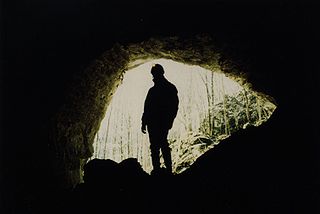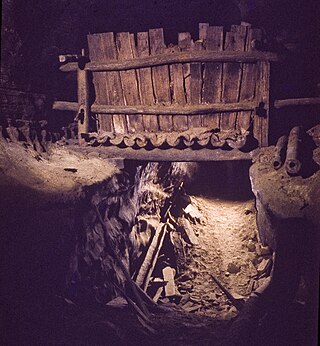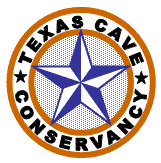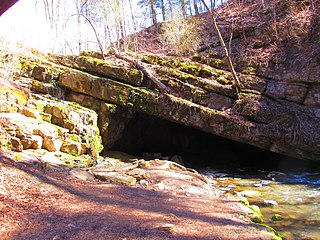
Speleology is the scientific study of caves and other karst features, as well as their composition, structure, physical properties, history, ecology, and the processes by which they form (speleogenesis) and change over time (speleomorphology). The term speleology is also sometimes applied to the recreational activity of exploring caves, but this is more properly known as caving, potholing, or spelunking. Speleology and caving are often connected, as the physical skills required for in situ study are the same.

The National Speleological Society (NSS) is an organization formed in 1941 to advance the exploration, conservation, study, and understanding of caves in the United States. Originally headquartered in Washington D.C., its current offices are in Huntsville, Alabama. The organization engages in the research and scientific study, restoration, exploration, and protection of caves. It has more than 10,000 members in more than 250 grottos.
The Cave Research Foundation (CRF) is an American private, non-profit group dedicated to the exploration, research, and conservation of caves. The group arose in the early 1950s from the exploration efforts at Floyd Collins Crystal Cave, now within Mammoth Cave National Park. Its stated goals were: to promote exploration and documentation of caves and karst areas, initiate and support cave and karst research, aid in cave conservation and protection, and to assist with the interpretation of caves and karst to the public.
Formed in 1956, the Australian Speleological Federation Inc. (ASF) is the national body representing those interested in the protection and sustainability of Australia's cave and karst environments. It has approximately 850 members across 28 constituent bodies throughout all Australian states and territories.
The Southeastern Cave Conservancy (SCCi) is a United States not-for-profit corporation dedicated to cave conservation, caver education, and cave management. It was formed in 1991 by a group of southeastern United States cavers. The SCCi is an institutional member of the National Speleological Society.

(Big) Bone Cave is a cave located in Van Buren County, Tennessee, in the community of Bone Cave that is named after it. It is notable both for its history and current recreational use. It is listed on the National Register of Historic Places and a designated National Natural Landmark. It is a 400-acre (161.9 ha) State Natural Area managed by Rock Island State Park. It is named for the discovery of the bones of a giant ground sloth in 1811. The cave was operated as a saltpeter mine, notably during the War of 1812 and the American Civil War. A variety of natural remains and human artifacts have been well preserved in the dry atmosphere of the cave. The cave is the 10th longest mapped cave in Tennessee.

The Texas Cave Conservancy was formed on October 13, 1994. This non-member, non-profit, 501 (c) (3) Texas corporation is dedicated to the protection of caves, cave life, and aquifers as related to caves. The TCC works through public education, scientific research and cave management by assisting land developers, municipalities, other non-profit organizations and private landowners in the protection and management of caves.

Snail Shell Cave is a limestone cave in Rockvale, Tennessee. Snail Shell Cave lies on an 88-acre (36 ha) preserve near Murfreesboro, Tennessee. Snail Shell cave is owned by the Southeastern Cave Conservancy, which has called it "one of the most biologically significant cave sites in the southeastern United States."

Tytoona Cave is located approximately 1-mile (1.6 km) from Arch Springs, Pennsylvania in Sinking Valley, near Tyrone and Altoona, in the United States.
The West Virginia spring salamander is a species of troglobitic salamander in the family Plethodontidae. It is endemic to West Virginia, the United States.
There are a number of caving organizations throughout the world.
Cave conservation is the protection and restoration of caves to prevent or minimise the effects of human activities.
The West Virginia Speleological Survey (WVaSS) is a speleological organization and ongoing cave survey program that has gathered information and published about West Virginia caves and karst since 1967.
The Southern California Grotto is a chapter of the National Speleological Society (NSS) based in the Greater Los Angeles area.

The Wittenberg University Speleological Society (WUSS) is a student-run grotto of the National Speleological Society (NSS) created in 1980, dedicated to the advancement of speleology. WUSS has more than 500 members, current and past students, faculty and staff of Wittenberg University, as well as community members dedicated to the scientific study, exploration, and preservation of caves and karst environments. The organization is based out of Wittenberg University in Springfield, Ohio.

The Butler Cave Conservation Society (BCCS) is a 501(c)(3) non-profit Virginia corporation dedicated to the conservation, exploration, survey, preservation, and scientific study of the caves and karst in and around Burnsville Cove, Virginia.
The Spanish Society of Speleology and Karst Science is a national caving organization of Spanish caving clubs to promote and disseminate the science of speleology and karst, founded in 1998.
Patricia Kambesis is an American caver, cartographer and educator.
Brewer, Richard, Conservancy: The Land Trust Movement in America, 2003, Dartmouth College/University Press of New England, 348 pp.







